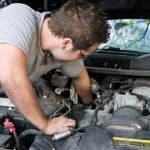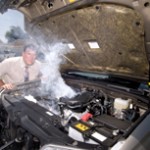 Don’t overlook safety features when comparing different models. Antilock brakes and electronic stability control, for instance, are effective and well worth the money. Remember, though, that the most important thing you can do to protect your life is to buckle your seatbelt. Safety belts save lives on their own, but many of the more advanced safety features, such as seatbelt pretensioners and air bags, only work best for people who are buckled up to start with.
Don’t overlook safety features when comparing different models. Antilock brakes and electronic stability control, for instance, are effective and well worth the money. Remember, though, that the most important thing you can do to protect your life is to buckle your seatbelt. Safety belts save lives on their own, but many of the more advanced safety features, such as seatbelt pretensioners and air bags, only work best for people who are buckled up to start with.
Here’s a rundown of some of the more important safety gear.
Air Bags
Front air bags are now standard on all new vehicles. Crash sensors connected to an onboard computer detect a frontal collision and trigger the bags. The bags inflate in a few milliseconds—the blink of an eye—then immediately start deflating. A new generation of adaptive, or dual-stage front air bags is standard on many current cars. Most of these adaptive systems can detect whether or not the seat belt is fastened, as well as the severity of a crash. In a low-level collision, the system inflates the front air bags less aggressively—with 70 to 80 percent of the force of a single-stage air bag. In a higher-speed collision they inflate with full force, providing firmer protection.
Many systems now use sensors that detect the presence and weight of the person in the passenger seat and deactivate or adjust the deployment of the air bag accordingly. The best air-bag systems can detect the presence, height, and seat position for the driver and front passenger, and deactivate or de-power front air bags as appropriate to minimize the chance of injury to out-of-position occupants or children.
Antilock brakes (ABS)
Before antilock brakes came along, it was all too easy to lock up the wheels (stop them turning) during hard braking, particularly on slippery surfaces. When the wheels lock up, the vehicle tends to keep plowing ahead in whatever direction it was going. You can’t steer, and locked wheels can cause a vehicle to slide sideways. ABS prevents this from happening. Antilock brakes use wheel-speed sensors at each wheel and a computer that coordinates the braking action, rapidly pulsing the brakes on and off when you hit the pedal hard. By preventing lock-up, ABS allows the driver to retain steering control while braking, so that the car can be maneuvered around an obstacle, if necessary.
Brake assist
Mercedes-Benz pioneered this adjunct to ABS. By sensing the speed or force with which the brake pedal is depressed, it determines if the driver wants to make an emergency stop. If so, it makes sure the ABS is activated and boosts brake pressure. Brake assist is widely available on luxury models and becoming a common option on many mainstream brands.
Traction control
This electronically controlled system limits wheel spin during acceleration so that the drive wheels have maximum traction. It’s particularly useful when starting off in wet or icy conditions. Some traction-control systems operate only at low speeds, while others work at all speeds.
Most low-speed traction-control systems use the car’s antilock brake system. If the system detects wheelspin while accelerating on a slippery surface, it momentarily applies the brakes to the slipping wheel. This stops the slipping and automatically routes power to the opposite drive wheel. All-speed traction control uses a combination of ABS and powertrain control. In slick conditions and at higher speeds, a system of sensors and computers may upshift the transmission, throttle back the engine, and apply the brakes—or a combination of these—to prevent wheelspin.
Safety-belt features
While the seatbelt is arguably the single most important piece of safety equipment, enhanced belt features are helping seatbelts do their job more effectively.
Adjustable upper anchors for the shoulder belts can make a meaningful safety difference. Adjustable anchors help position the belt across the chest instead of the neck to prevent neck injuries. They also can help keep the belt from pulling down on a tall person’s shoulder, making it more comfortable and encouraging its use.
Seatbelt pretensioners instantly retract the belts to take up slack during a frontal impact. This also helps position occupants properly to take full advantage of a deploying airbag. Force limiters, a companion feature to pretensioners, manage the force that the shoulder belt builds up on the occupant’s chest. After the pretensioners tighten it, force limiters let the belt pay back out a little.
LATCH (Lower Anchors and Tethers for Children)
All vehicles are now required to have the LATCH system. The system features built-in lower anchors and top-tether attachment points allowing LATCH-compatible child safety seats to be installed without using the vehicle’s safety-belt system. The LATCH system helps child-seat installation by reducing incompatibilities that safety-belt installation may present. But we’ve found a number of cars and trucks whose LATCH system is tough to use correctly, so try before you buy a new child seat.
Electronic stability control (ESC)
Electronic stability control takes electronic traction control a step further. This system helps keep the vehicle on its intended path during a turn, to avoid sliding or skidding. It uses a computer linked to a series of sensors—detecting wheel speed, steering angle, sideways motion and yaw (spin). If the car starts to drift, the stability-control system momentarily brakes one or more wheels and, depending on the system, reduces engine power to keep the car back on course.
ESC is especially helpful in providing an extra measure of control in slippery conditions and accident-avoidance situations. With tall, top-heavy vehicles like sport-utilities and pickups, it can also help keep a vehicle from getting into a situation where it could roll over.
Ford and Volvo took stability control a step further with Roll Stability Control (RSC). It uses gyroscopic sensors to determine roll angle and roll speed to determine if a rollover is imminent. If so, it triggers the standard stability control system and instantly reduces power and brakes the necessary wheels to bring the vehicle back under control.
Tire-pressure monitor
Underinflated tires can hurt handling and fuel economy, as well as cause premature wear—or a possible blowout—of the tire. Yet a tire can lose air so slowly that many drivers don’t realize it’s happening. A government regulation requires all new vehicles made after October 31, 2006 to have a low-tire-pressure warning system. The type of tire-pressure monitor we favor measures tire pressure directly. A competing technology, and one the government has approved, gauges air loss indirectly by using sensors to count wheel revolutions. We don’t think those systems are sensitive enough. In any case, we suggest regularly checking your tires with a conventional tire-pressure gauge.
Telematics
Combining cellular telephone and Global Positioning Satellite (GPS) technology, several major automakers are offering an automated service that provides a high level of security and convenience. GM was the first with its OnStar service, followed later by Mercedes-Benz’s TeleAid, BMW Assist, Volvo OnCall, and Lexus Link. All use the same technology and offer basically the same services. In operation, with the touch of a button the driver can communicate with a central dispatch center, where the location of the vehicle can be tracked on a computer monitor to provide route directions or emergency aid. If a vehicle’s air bag is deployed in a collision, the system automatically notifies the dispatch center, locates the vehicle, and sends emergency aid if the driver does not respond to an inquiry. A phone call to the dispatch center can find a “lost” car in a parking lot by beeping the horn, or unlock the doors if the keys have been misplaced. OnStar is available on all GM cars and trucks, as well as on Saab, Acura, Audi, and other makes. TeleAid is offered only on Mercedes-Benz models. Additional systems include BMW’s Assist and Volvo’s Oncall. The cost of the system is built into the price of most vehicles, but a monthly service fee is usually required.
Adopted From: www.consumerreports.org/cro/cars/new-cars/news/2006/safety-features-to-look-for










